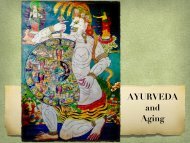How Thoreau's Walden Pond Mixed with the Ganges and Yoga Came to America with Swami Vivekananda
One early morning in 1846, during the coldest days of a New England winter, Henry David Thoreau looked out the window of his small cabin on Walden Pond and saw men cutting its ice into blocks. That ice was hauled by horse to a railroad that ran across the western edge of Walden Pond, packed into a boxcar, taken to Boston and loaded onto a clipper ship that sailed to Calcutta, India, arriving about four months later. Once there, that ice was purchased by grateful members of the East India Company. Thoreau had witnessed a small part of the global ice trade between New England and India that took place during the latter part of the nineteenth century. When Thoreau considered the ice trade, his vision sailed on metaphors far beyond the scope of business. The waters he imagined flowed both east and west and carried not just natural elements, but culture, religion and philosophy as well. He envisioned that after arriving in Calcutta, the New England ice of Walden Pond would eventually melt and run downhill where it would join with the sacred water of the Ganges. He wrote in Walden: "It appears that the sweltering inhabitants of Charleston and New Orleans, of Madras and Bombay and , drink at my well. In the morning I bathe my intellect in the stupendous and cosmogonal philosophy of the , since whose composition years of the gods have elapsed, and in comparison with which our modern world and its literature seem puny and trivial; and I doubt if that philosophy is not to be referred to a previous state of existence, so remote is its sublimity from our conceptions. I lay down the book [Bhagavad-Gita] and go to my well for water, and lo! there I meet the servant of the Bramin, priest of and and who still sits in his temple on the Ganges reading the , or dwells at the root of a tree with his crust and water jug. I meet his servant come to draw water for his master, and our buckets as it were grate together in the same well. The pure Walden water is mingled with the sacred water of the Ganges." This book tells the story of these waters . . .
One early morning in 1846, during the coldest days of a New England winter, Henry David Thoreau looked out the window of his small cabin on Walden Pond and saw men cutting its ice into blocks. That ice was hauled by horse to a railroad that ran across the western edge of Walden Pond, packed into a boxcar, taken to Boston and loaded onto a clipper ship that sailed to Calcutta, India, arriving about four months later. Once there, that ice was purchased by grateful members of the East India Company. Thoreau had witnessed a small part of the global ice trade between New England and India that took place during the latter part of the nineteenth century.
When Thoreau considered the ice trade, his vision sailed on metaphors far beyond the scope of business. The waters he imagined flowed both east and west and carried not just natural elements, but culture, religion and philosophy as well. He envisioned that after arriving in Calcutta, the New England ice of Walden Pond would eventually melt and run downhill where it would join with the sacred water of the Ganges. He wrote in Walden: "It appears that the sweltering inhabitants of Charleston and New Orleans, of Madras and Bombay and , drink at my well. In the morning I bathe my intellect in the stupendous and cosmogonal philosophy of the , since whose composition years of the gods have elapsed, and in comparison with which our modern world and its literature seem puny and trivial; and I doubt if that philosophy is not to be referred to a previous state of existence, so remote is its sublimity from our conceptions.
I lay down the book [Bhagavad-Gita] and go to my well for water, and lo! there I meet the servant of the Bramin, priest of and and who still sits in his temple on the Ganges reading the , or dwells at the root of a tree with his crust and water jug. I meet his servant come to draw water for his master, and our buckets as it were grate together in the same well. The pure Walden water is mingled with the sacred water of the Ganges."
This book tells the story of these waters . . .
Create successful ePaper yourself
Turn your PDF publications into a flip-book with our unique Google optimized e-Paper software.
Nivedita<br />
Sister Nivedita; born Margaret Elizabeth Noble;<br />
28 Oc<strong>to</strong>ber 1867 – 13 Oc<strong>to</strong>ber 1911) was<br />
a Scots-Irish social worker, author, teacher <strong>and</strong><br />
a disciple of <strong>Swami</strong> Vivekan<strong>and</strong>a. She spent<br />
her childhood <strong>and</strong> early days of her youth in<br />
Irel<strong>and</strong>. From her fa<strong>the</strong>r, from her college professor<br />
etc. she learned many valuable lessons<br />
like – service <strong>to</strong> mankind is <strong>the</strong> true service <strong>to</strong><br />
God. She worked as school teacher <strong>and</strong> later<br />
also opened a school. She was committed <strong>to</strong><br />
marry a Welsh youth who died soon after engagement.<br />
Sister Nivedita met <strong>Swami</strong> Vivekan<strong>and</strong>a in<br />
1895 in London <strong>and</strong> travelled <strong>to</strong> Calcutta, India<br />
(present-day Kolkata) in 1898. <strong>Swami</strong><br />
Vivekan<strong>and</strong>a gave her <strong>the</strong> name Nivedita (meaning "Dedicated <strong>to</strong> God") when<br />
he initiated her in<strong>to</strong> <strong>the</strong> vow of Brahmacharya on 25 March 1898. In November<br />
1898, she opened a girls' school in Bagbazar area of Calcutta. She wanted <strong>to</strong><br />
educate those girls who were deprived of even basic education. During <strong>the</strong><br />
plague epidemic in Calcutta in 1899 Nivedita nursed <strong>and</strong> <strong>to</strong>ok care of <strong>the</strong> poor<br />
patients.<br />
Nivedita had close associations <strong>with</strong> <strong>the</strong> newly established Ramakrishna Mission.<br />
<strong>How</strong>ever, because of her active contribution in <strong>the</strong> field of Indian Nationalism,<br />
she had <strong>to</strong> publicly dissociate herself from <strong>the</strong> activities of <strong>the</strong> Ramakrishna<br />
Mission under <strong>the</strong> <strong>the</strong>n president <strong>Swami</strong> Brahman<strong>and</strong>a. She was very intimate<br />
<strong>with</strong> Sarada Devi, <strong>the</strong> spiritual consort of Ramakrishna <strong>and</strong> one of <strong>the</strong> major influences<br />
behind Ramakrishna Mission <strong>and</strong> also <strong>with</strong> all bro<strong>the</strong>r disciples of<br />
<strong>Swami</strong> Vivekan<strong>and</strong>a. She died on 13 Oc<strong>to</strong>ber 1911 in Darjeeling. Her epitaph<br />
reads, "Here reposes Sister Nivedita who gave her all <strong>to</strong> India.”<br />
– Wikipedia, The Free Encyclopedia<br />
Related Glossary Terms<br />
Drag related terms here<br />
Index<br />
Find Term


















